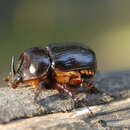Coleoptera Overview
(
englanti
)
tarjonnut EOL authors
Order Coleoptera has the most insect species.Beetles can be found throughout the world and can vary from a millimeter to 75 millimeters in length.They have an open circulatory system that uses fluid instead of blood.Most beetles have two pairs of wings, one pair is hardened and the other pair is membranous.Their antennae are mostly used for their sense of smell.They have spiracles, which are breathing holes on their abdomen.Most beetles feed on plants, but other species are predaceous.Some species are aquatic and have a hard exoskeleton.Some species are sexually dimorphic.This can be seen when males have horns on their head.Most beetles undergo complete metamorphosis.They go through several stages from: the egg, the grub, the pupa, and the adult (also known as an imago).Most beetles have a gland that produces pheromones to attract a mate.Beetles can be found in the fossil record as far back as the Lower Permian.People release beetles to control common pests, for instance, ladybugs are released into gardens to control aphid populations.
- lisenssi
- cc-by-3.0
- tekijänoikeus
- Rhianna Hruska
Coleoptera-Atlas.com
(
englanti
)
tarjonnut EOL authors
The aim of this site is to show the world the beauty and diversity of coleoptera, whilst being accessible to new comers intrigued by their beauty and array, to amateurs who are keen to learn more, and for professionals alike.
At the time of reading this site has over 6000 species which have all been classified, plus 2000 macrophotos which are constantly upgraded and will give you a new facility for identifying and classifying beetles.
Pollinator
(
englanti
)
tarjonnut EOL authors
Early beetles appear to have been among the primary visitors of primitive flowering plants. An improvement over wind pollination, beetles likely played an important role in the evolution of flowering plants. Many familiar North American plants are pollinated by beetles. For example, plants in the magnolia family, including the eight species that are native to the United States, have flowers that are specialized for beetle pollination. In fact, though magnolia flowers are often described as "primitive" (relatively unchanged from the ancestral type), some researchers have suggested that magnolia flowers are actually quite specialized and have evolved to promote nearly exclusive pollination by beetles. The beetles appear to be attracted by the odor of the flowers - which is sometimes described as unpleasant - as well as their color. They feed on nectar, stigmas, pollen, and secretions of the petals. Other insects appear to be unable to access magnolia flowers at critical times, while stigmas are mature or while pollen is shed. At least some magnolia species, including one species in Mexico, produce heat. Odor, often foul or unpleasant, is thought to act as a primary attractant for many beetle and fly pollinators. Beetle-pollinated plants additionally produce heat. The odor may mimic a food source; the heat is thought to help spread the odor and/or provide a direct energetic benefit to pollinating insects
- lisenssi
- cc-publicdomain
- tekijänoikeus
- National Biological Information Infrastructure (NBII) at http://www.nbii.gov

